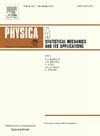Interface-packing analysis of F1-ATPase using integral equation theory and manifold learning
IF 2.8
3区 物理与天体物理
Q2 PHYSICS, MULTIDISCIPLINARY
Physica A: Statistical Mechanics and its Applications
Pub Date : 2024-10-28
DOI:10.1016/j.physa.2024.130201
引用次数: 0
Abstract
It has been shown that the translational entropy of water plays a key role in biological processes such as protein folding and ligand binding. Under the physiological condition, tightly packed protein conformations like native structures are achieved so that the translational entropy of water is maximized. In this study, we investigate the rotation mechanism of a rotary protein motor, F1-ATPase, by analyzing the packing at the interfaces between the subunits. The packing at the interface between a subunit pair is analyzed using the change in the solvent entropy upon forming subunit pair, . It is found that as the γ subunit rotates, the value of a α-β subunit pair decrease because the interface packing becomes loose. However, because the interface packing of another α-β subunit pair becomes tighter upon the rotation, of this α-β subunit pair increases, leading to a compensation of the decrease in . Such compensation would be necessary to maximize the solvent entropy of F1-ATPase. In this study, packing at the interfaces between the subunits is also analyzed using a manifold-learning technique, and it is suggested a possibility that a qualitative estimation of the values of some α-β subunit pairs can be predicted using a manifold-learning technique.
利用积分方程理论和流形学习对 F1-ATP 酶进行界面堆积分析
研究表明,水的平移熵在蛋白质折叠和配体结合等生物过程中起着关键作用。在生理条件下,蛋白质的紧密构象与原生结构类似,从而使水的平移熵达到最大。在本研究中,我们通过分析亚基间界面的堆积,研究了旋转蛋白马达 F1-ATP 酶的旋转机制。我们利用形成亚基对时溶剂熵的变化 ∆S 来分析亚基对界面的堆积。结果发现,随着 γ 亚基的旋转,α-β 亚基对的∆S 值会降低,因为界面填料变得松散。然而,由于另一对 α-β 亚基的界面填料在旋转时变得更紧密,这对α-β 亚基的 ∆S 值就会增加,从而补偿了 ∆S 值的减少。要使 F1-ATP 酶的溶剂熵最大化,这种补偿是必要的。本研究还利用流形学习技术分析了亚基间界面的填料,并提出了一种可能性,即利用流形学习技术可以对某些 α-β 亚基对的∆S 值进行定性估计。
本文章由计算机程序翻译,如有差异,请以英文原文为准。
求助全文
约1分钟内获得全文
求助全文
来源期刊
CiteScore
7.20
自引率
9.10%
发文量
852
审稿时长
6.6 months
期刊介绍:
Physica A: Statistical Mechanics and its Applications
Recognized by the European Physical Society
Physica A publishes research in the field of statistical mechanics and its applications.
Statistical mechanics sets out to explain the behaviour of macroscopic systems by studying the statistical properties of their microscopic constituents.
Applications of the techniques of statistical mechanics are widespread, and include: applications to physical systems such as solids, liquids and gases; applications to chemical and biological systems (colloids, interfaces, complex fluids, polymers and biopolymers, cell physics); and other interdisciplinary applications to for instance biological, economical and sociological systems.

 求助内容:
求助内容: 应助结果提醒方式:
应助结果提醒方式:


